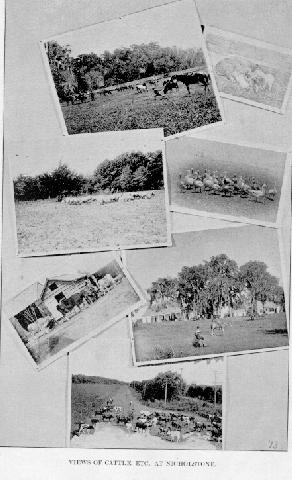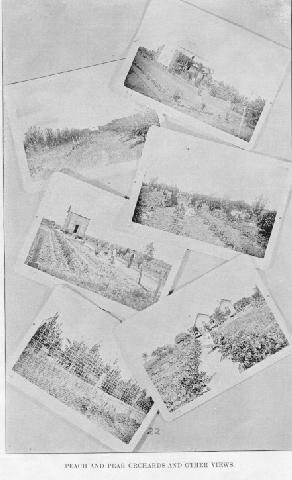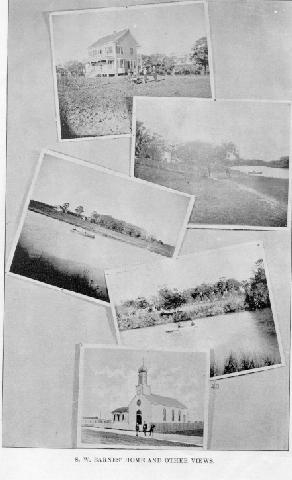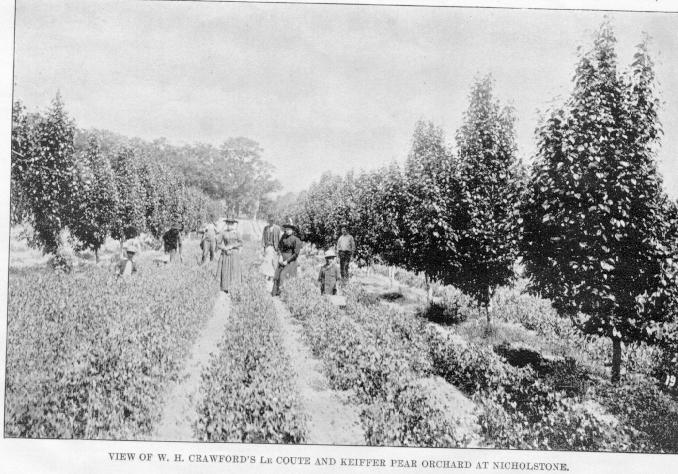--------------
Now the Nicholstone country contains hundreds of industrious and
well-to-do settlers. The analysis of the soil, made by the United States
chemist, and printed in the Census Report of 188O, shows it to be the most
fertile along the Texas coast.
The climate is mild and equable.
The rainfall is ample, being from 48 to 52 inches during the year.
The soil is sub-irrigated, and resists drouth in a most satisfactory man-
ner. The purest of water for drinking and household purposes can be
obtained either from springs or wells. Artesian water of the purest qual-
ity is reached at depth of 500 feet: in ordinary wells, at a depth of 14 feet.
So far as the possibilities of the Nicholstone country are concerned
in the cultivation of fruits and vegetables, they are only beginning to be
realized. It is the home of the Le Conte and Keiffer pear. Strawberries
yield a rich return to those who properly plant and cultivate them. Pears
have neven been known to blight, and there are trees of the Duchesse
d'Angouleme variety which have. grown in this section for more than forty
years. Peaches, plums, apricots, figs, grapes, and nectarines do well,
as also the Japan persimmon. Blackberries and dewberries are indigenous,
and yield good returns.
The Nicholstone country is an excellent location for dairymen. Milk
sells at 10 cents per quart, butter from 25 to 50 cents per pound, and cream
cheese for 10 cents per mould.
Fine stock can be raised at a profit, Holsteins and Jerseys bringing
from $35 to $150 per head. Shetland ponies can also be bred successfully.
Horses and ponies bring from $25 to $50, and mules from $50 to $300. Sheep
and hogs can be raised at a profit, and there is always a brisk demand for
coast country poultry and eggs.
Other field crops not before mentioned that do well and yield a profit
are cotton, corn, rye, wheat, alfalfa, hay, clover, millet, oats, etc.
All descriptions of vegetables do well, and on account of their early

Views of cattle, etc., at Nicholstone
-28-

Peach and pear orchards and other views
-29-

S.W. Barnes home and other views
-30-
maturity command excellent prices in the market of the West and North-
west. Hundreds of car-loads of carly cabbage and Irish potatoes are shipped
from the coast country every spring.
Among the numerous agricultural enterprises now under way in
the Nicholstone country is the cultivation of the ramie and jute plant.
The company having the farm in charge have disposed of a number of
plants and the demand is still increasing. The ramie fiber is utilized for
all the purposes to which silk is adapted. India jute Is used in the man-
ufacture of bagging, sacks, etc. Both grow luxuriantly in the Nicholstone
country, reaching a height of 12 to 14 feet in a single season.
The Empsom Packing Company of Colorado has 655 acres in cultiva-
tion. Have planted 65,000 fruit trees of different varieties, and put a large
acreage in vegetables.
The Galveston Nursery and Orchard Co. has 1,100 acres under cultiva-
tion in the Nicholstone country. It is in charge of Professor F. W. Mally,
and Is devoted to the propagation of all kinds of nursery stock.
Among the recent purchases in the Nicholstone country is that of the
Norwegian colony, comprising 3,000 acres, which has been taken up in
tracts varying from 25 to 50 acres by industrious Scandinavians from the
Northwest.
Just as true as that "All roads lead to Rome," so all Southwestern
railways are leading towards Galveston, the present deep-water port of the
Gulf. To get there they must pass through the Nicholstone property.
This means increased transportation facilities. and a great enhance-
ment in the value of the Nicholstone City Company's lands.
We offer special inducements to emigration agents or to parties desir-
ing to locate colonies.
or further information to parties seeking a home, or a good invest- ment, cheap railway tickets, call on or write to

-32-
end
Nicholstone on the Bayou
Nicholstone before 1900
1998Jan21 revised 2021Mar22